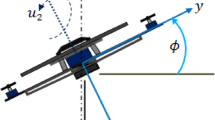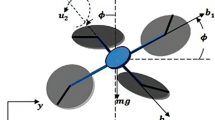Abstract
Accurate and precise trajectory tracking is crucial for unmanned aerial vehicle (UAVs) to operate in disturbed environments. This paper presents a novel tracking hybrid controller for a quadrotor UAV that combines the robust adaptive neuro-fuzzy inference system (ANFIS) controller and Improved Particle Swarm Optimization algorithm (IPSO) model based on functional inertia weight. The controller is implemented in a three degrees of freedom (3 DOF) quadrotor symbolized with its non-linear dynamical mathematical model. To achieve Cartesian position trajectory tracking capability, the construction of the controller can be divided into two stages: a regular ANFIS controller to guarantee fast convergence rapidity and IPSO aims to facilitate convergence to the ANFIS’s optimal parameters to accurately reproduce a desired reference trajectory. Simulation results are given to confirm the advantages of the proposed intelligent control, compared with ANFIS and PID control methods.
























Similar content being viewed by others
References
Mostafa SA, Ahmad MS, Mustapha A (2017) Adjustable autonomy: a systematic literature review. Artif Intell Rev 1–38
Lozano R (2010) Unmanned Aerial Vehicles: Embedded Control. Wiley, Hoboken
Barnhart R, Hottman S, Marshall D, Shappee E (2012) Introduction to unmanned aircraft systems. CRC Press, Taylor & Francis Group, Boca Raton, Fl
Nonami K, Kendoul F, Suzuki S, Wang W, Nakazawa D (2010) Autonomous flying robots: unmanned aerial vehicles and micro aerial vehicles. Springer, Berlin
Austin R (2010) Unmanned Aircraft Systems: UAVS Design Development and Deployment. Wiley, New York
Valavanis KP (2007) Advances in unmanned aerial vehicles: state of the art and the road to autonomy. Springer, Dordrecht
De Filippis L, Guglieri G, Quagliotti F (2011) A minimum risk approach for path planning of UAVs. J Intell Robot Syst 61(1):203–219
Primatesta S, Guglieri G, Rizzo A (2018) A risk-aware path planning method for unmanned aerial vehicles. In: International Conference on Unmanned Aircraft Systems (ICUAS), IEEE pp 905–913
Mahadevan P (2010) The military utility of drones. CSS Anal Secur Policy 1–3
Zhang L, Mu L, Liu Z, Zhang Y, Ai J (2018) Automated maneuvering decision for UAVs in forest surveillance and fire detection missions. International Conference on Unmanned Aircraft Systems (ICUAS), pp 1085–1090
Ma L, Li MC, Wang YF, Tong LH, Cheng L (2013) Using high-resolution imagery acquired with an autonomous unmanned aerial vehicle for urban construction and planning. In: Proceeding International Confress on Remote Sensing, Environment and Transportation Engineering (RSETE 2013), Najing, China, 31, 200–203
Knyaz VA, Chibunichev AG (2016) Photogrammetric techniques for road surface analysis. In: ISPRS-International Archives of the Photogrammetry, Remote Sensing and Spatial Information Sciences. Prague, Czech Republic, 515–520. https://doi.org/10.5194/isprs-archives-XLI-B5-515-2016
Kanistras K, Martins G, Rutherford MJ, Valavanis KP (2014) Survey of Unmanned Aerial Vehicles (UAVs) for traffic monitoring. In: Handbook of Unmanned Aerial Vehicles. Springer, pp 2643–2666. https://doi.org/10.1109/ICUAS.2013.6564694
Chow JYJ (2016) Dynamic UAV-based traffic monitoring under uncertainty as a stochastic arc-inventory routing policy. Int J Transp Sci Technol 5(3):167–185
Reinartz P, Lachaise M, Schmeer E, Krauss T, Runge H (2006) Traffic monitoring with serial images from airborne cameras. ISPRS J Photogramm Remote Sens 61:149–158. https://doi.org/10.1016/j.isprsjprs.2006.09.009
European Aviation Safety Agency (2016) Prototype. Commission Regulation on Unmanned Aircraft Operations, Cologne, Germany
Siebert S, Teizer J (2014) Mobile 3D mapping for surveying earthwork projects using an unmanned aerial vehicle (UAV) system. Autom Constr 41:1–14. https://doi.org/10.1016/j.autcon.2014.01.004
Valente J, Del Cerro D, Barrientos A, Sanz D (2013) Aerial coverage optimization in precision agriculture management: a musical harmony inspired approach. Comput Electron Agric 99:153–159
Freeman PK, Freeland RS (2014) Politics and technology: US polices restricting unmanned aerial systems in agriculture. Food Policy 49(1):302–311
Wang R, Liu J (2018) Trajectory tracking control of a 6-DOF quadrotor UAV with input saturation via backstepping. J Frankl Inst Eng Appl Math 355(7):3288–3309
Chen F, Jiang R, Zhang K, Jiang B, Tao G (2016) Robust Backstepping sliding-mode control and observer-based fault estimation for a quadrotor UAV. IEEE Trans Ind Electron 63(8):5044–5056
Liu H, Li D, Zuo Z, Zhong Y (2016) Robust three-loop trajectory tracking control for quadrotors with multiple uncertainties. IEEE Trans Ind Electron 63(4):2263–2274
Kamel M, Burri M, Siegwart R (2017) Linear vs Nonlinear MPC for Trajectory Tracking Applied to Rotary Wing Micro Aerial Vehicles. IFAC-PapersOnLine, 50(1), 3463–3469, ISSN 2405–8963, https://dx.doi.org/10.1016/j.ifacol.2017.08.849
Ríos H, Falcón R, González OA, Dzul A (2019) Continuous sliding-mode control strategies for quadrotor robust tracking: real-time application. IEEE Trans Ind Electron 66(2):1264–1272
Tian B, Lu H, Zuo Z, Zong Q, Zhang Y (2018) Multivariable finite-time output feedback trajectory tracking control of quadrotor helicopters. Int J Robust Nonlinear Control 28(1):281–295
Wendong G, Jie L, Chengzhi Q, Jing Z (2018) Trajectory tracking control for a quadrotor UAV via extended state observer. Syst Sci Control Eng 6(3):126–135. https://doi.org/10.1080/21642583.2018.1539931
Jang JSR (1993) ANFIS: Adaptive-Network-based Fuzzy Inference Systems. IEEE Trans Syst Man Cybern 23(3):665–685
Abido MA, Khalid MS, Worku MY (2015) An efficient ANFIS based PI controller for maximum power point tracking of PV systems. Arab J Sci Eng 40(9):2641–2651
Ponce P, Molina A, Cayetano I, Gallardo J, Salcedo H, Rodriguez J (2015) Experimental fuzzy logic controller type 2 for a quadrotor optimized by anfis. IFAC PapersOnLine 48(3):2435–2441
Barman B, Kanjilal R, Mukhopadhyay A (2016) Neuro-Fuzzy Controller Design to Navigate Unmanned Vehicle with Construction of Traffic Rules to Avoid Obstacles. Int J Uncertain Fuzziness Knowl Based Syst 24(3):433–449
Ponce P, Molina A, Cayetano I, Gallardo J, Salcedo H, Rodriguez J, Carrera I (2016) Fuzzy logic sugeno controller type-2 for quadrotors based on anfis. Nature-inspired computing for control systems, Springer, Cham pp 195–230.
Solaiappan BS, Nagappan K (2017) AGC for multisource deregulated power system using ANFIS controller. Int Trans Electr Energ Syst 27(3):e2270. https://doi.org/10.1002/etep.2270
Ounnas D, Ramdani M, Chenikher S, Bouktir T (2017) An efficient maximum power point tracking controller for photovoltaic systems using Takagi-Sugeno fuzzy models. Arab J Sci Eng 42:4971–4982. https://doi.org/10.1007/s13369-017-2532-0
Kharola A (2017) Design of a hybrid adaptive neuro fuzzy inference system (ANFIS) controller for position and angle control of inverted pendulum (IP) systems. Int J Fuzzy Syst Appl (IJFSA) 5(1):27–42
Khatoon S, Nasiruddin I, Shahid M (2017) Design and simulation of a hybrid PD-ANFIS controller for attitude tracking control of a quadrotor UAV. Arab J Sci Eng 42(12):5211–5229
Dorzhigulov A, Bissengaliuly B, Spencer BF Jr, Kim J, James AP (2018) ANFIS based quadrotor drone altitude control implementation on Raspberry Pi platform. Analog Integr Circuits Signal Process 95(3):435–445
Aldair AA, Obed AA, Halihal AF (2018) Design and implementation of ANFIS-reference model controller based MPPT using FPGA for photovoltaic system. Renew. Sustain. Energy Rev. 82(Part 3):2202–2217, https://doi.org/10.1016/j.rser.2017.08.071
Ismail MM, Bendary AF (2020) Smart battery controller using ANFIS for three phase grid connected PV array system. Math Comput Simulation 167:104–118
Gaur P, Singh B, Mittal AP, Arora S (2019) Implementation of ANFIS Controller-Based Algorithm Measuring Speed to Eliminate RDC Hardware in Resolver-Based PMSM. In: Singh S, Wen F, Jain M (eds) Advances in System Optimization and Control Lecture Notes in Electrical Engineering. Springer, Singapore, pp 147–159
Dixit TV, Yadav A, Gupta S, Abdelaziz AY (2019) Power Extraction from PV Module Using Hybrid ANFIS Controller. In: Precup RE, Kamal T, Zulqadar Hassan S (eds) Solar Photovoltaic Power Plants Power Systems. Springer, Singapore, pp 209–232
Kennedy J, Eberhart RC (1995) Particle swarm optimization. In: Proceedings of the IEEE international conference on neural networks, Perth, Australia, pp 1942–1948
Eberhart RC, Kennedy J (1995) A new optimizer using particle swarm theory. In: Proceedings of the 6th International Symposium on Micro Machine and Human Science, Nagoya, New York, pp 39–43
Eberhart R, Simpson P, Dobbins R (1996) Computational Intelligence PC Tools. Academic Press Professional, Inc., San Diego 0-12-228630-8
Dréo J, Petrowski A, Siarry P, Taillard E (2003) Métaheuristiques pour l’optimisation Difficile. Eyrolles, Paris
Clerc M, Siarry P (2009). Une méthode inspirée de comportements coopératifs observés dans la nature : l’optimisation par essaim particulaire. Revue d’Electricité et d’Electronique REE, pp 25–32
Shi Y, Eberhart RC (1999) Empirical study of particle swarm optimization. In: CEC 99. Proceedings of the congress on IEEE evolutionary computation, vol 3, pp 1945–1950.
Funding
The authors received no financial support for the research, authorship, and/or publication of this article.
Author information
Authors and Affiliations
Corresponding author
Ethics declarations
Conflict of interest
The authors declare that they have no conflict of interest.
Rights and permissions
About this article
Cite this article
Selma, B., Chouraqui, S. & Abouaïssa, H. Optimal trajectory tracking control of unmanned aerial vehicle using ANFIS-IPSO system. Int. j. inf. tecnol. 12, 383–395 (2020). https://doi.org/10.1007/s41870-020-00436-6
Received:
Accepted:
Published:
Issue Date:
DOI: https://doi.org/10.1007/s41870-020-00436-6




